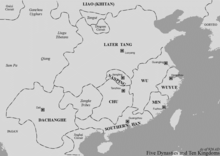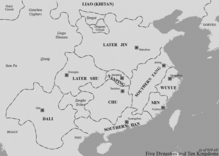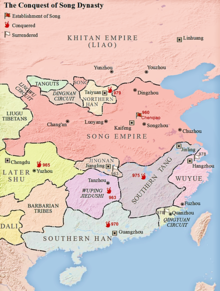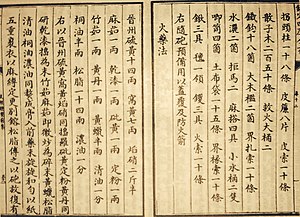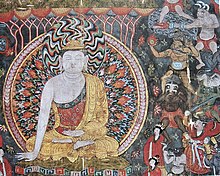
The Five Dynasties and Ten Kingdoms period was an era of political upheaval and division in Imperial China from 907 to 979. Five dynastic states quickly succeeded one another in the Central Plain, and more than a dozen concurrent dynastic states, collectively known as the Ten Kingdoms, were established elsewhere, mainly in South China. It was a prolonged period of multiple political divisions in Chinese imperial history.
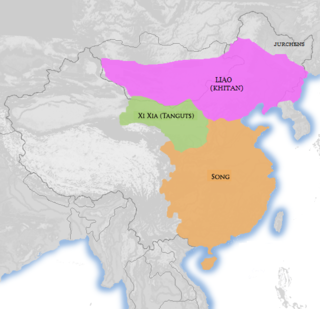
The Western Xia or the Xi Xia (Chinese: 西夏; pinyin: Xī Xià; Wade–Giles: Hsi1 Hsia4), officially the Great Xia (大夏; Dà Xià; Ta4 Hsia4), also known as the Tangut Empire, and known as Mi-nyak to the Tanguts and Tibetans, was a Tangut-led imperial dynasty of China that existed from 1038 to 1227. At its peak, the dynasty ruled over modern-day northwestern China, including parts of Ningxia, Gansu, eastern Qinghai, northern Shaanxi, northeastern Xinjiang, and southwest Inner Mongolia, and southernmost Outer Mongolia, measuring about 800,000 square kilometres (310,000 square miles).
This is a list of historical capitals of China.

The Zizhi Tongjian (1084) is a chronicle published during the Northern Song dynasty (960–1127) that provides a record of Chinese history from 403 BC to 959 AD, covering 16 dynasties and spanning almost 1400 years. The main text is arranged into 294 scrolls, each equivalent to a chapter—totaling around 3 million Chinese characters.
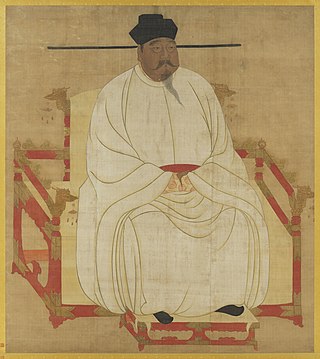
Emperor Taizu of Song, personal name Zhao Kuangyin, courtesy name Yuanlang, was the founding emperor of the Song dynasty of China. He reigned from 960 until his death in 976. Formerly a distinguished military general of the Later Zhou dynasty, Emperor Taizu came to power after staging a coup d'état and forcing Emperor Gong, the last Later Zhou ruler, to abdicate the throne in his favor.
Taizu is a temple name typically, but not always, used for Chinese monarchs who founded a particular dynasty, may refer to:

Southern Tang was a dynastic state of China that existed during Five Dynasties and Ten Kingdoms period. Located in southern China, the Southern Tang proclaimed itself to be the successor of the Tang dynasty. The capital was located at Nanjing in present-day Jiangsu Province. At its territorial peak in 951, the Southern Tang controlled the whole of modern Jiangxi, and portions of Anhui, Fujian, Hubei, Hunan, and Jiangsu provinces.

Abaoji, posthumously known by his temple name as the Emperor Taizu of Liao, was a Khitan leader and the founding emperor of the Liao dynasty of China, ruling from 916 to 926. He had a sinicised name, Yelü Yi; some sources suggest that Abaoji's family name, Yelü, was adopted during his lifetime, although there is no consensus amongst historians on this point.

The Sixteen Prefectures of Yanyun comprise a historical region in northern China along the Great Wall in present-day Beijing, Tianjin, and part of northern Hebei and Shanxi. It was a site of constant military and political conflict between various dynasties from the end of the Tang dynasty until the establishment of the Yuan dynasty.
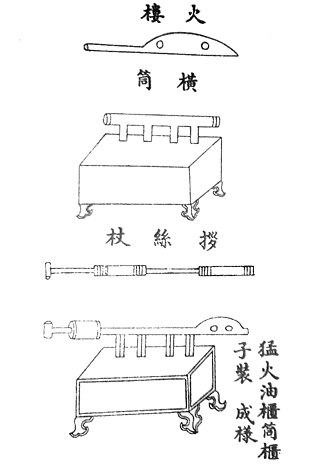
The Fierce-fire Oil Cabinet was a double-piston pump naphtha flamethrower first recorded to have been used in 919 AD in China, during the Five Dynasties and Ten Kingdoms period.

The Shatuo, or the Shatuo Turks were a Turkic tribe that heavily influenced northern Chinese politics from the late ninth century through the tenth century. They are noted for founding three, Later Tang, Later Jin, and Later Han, of the five dynasties and one, Northern Han, of the ten kingdoms during the Five Dynasties and Ten Kingdoms period. The Northern Han would later be conquered by the Song dynasty. Sometime before the 12th century, the Shatuo disappeared as a distinct ethnic group, many of them having become acculturated and assimilating into the general population around them.
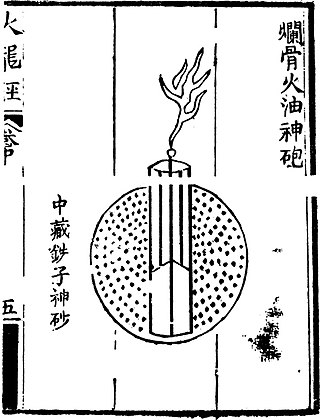
Jiao Yu was a Chinese military general, philosopher, and writer of the Yuan dynasty and early Ming dynasty under Zhu Yuanzhang, who founded the dynasty and became known as the Hongwu Emperor. He was entrusted by Zhu as a leading artillery officer for the rebel army that overthrew the Mongol Yuan dynasty, and established the Ming dynasty.
This is a family tree of Chinese monarchs from the Northern and Southern dynasties period to the collapse of the Southern Song dynasty.
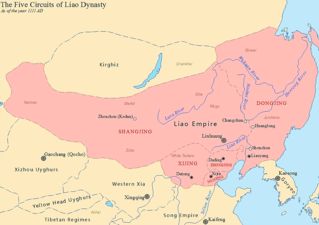
The Liao dynasty, also known as the Khitan Empire, officially the Great Liao, was an imperial dynasty of China that existed between 916 and 1125, ruled by the Yelü clan of the Khitan people. Founded around the time of the collapse of the Tang dynasty, at its greatest extent it ruled over Northeast China, the Mongolian Plateau, the northern part of the Korean Peninsula, southern portions of the Russian Far East, and the northern tip of the North China Plain.
Gunpowder weapons in the Song dynasty included fire arrows, gunpowder lit flamethrowers, soft shell bombs, hard shell iron bombs, fire lances, and possibly early cannons known as "eruptors". The eruptors, such as the "multiple bullets magazine eruptors", consisting of a tube of bronze or cast iron that was filled with about 100 lead balls, and the "flying-cloud thunderclap eruptor", were early cast-iron proto-cannons that did not include single shots that occluded the barrel. The use of proto-cannon, and other gunpowder weapons, enabled the Song dynasty to ward off its generally militarily superior enemies—the Khitan led Liao, Tangut led Western Xia, and Jurchen led Jin—until its final collapse under the onslaught of the Mongol forces of Kublai Khan and his Yuan dynasty in the late 13th century.

The Jin–Song Wars were a series of conflicts between the Jurchen-led Jin dynasty (1115–1234) and the Han-led Song dynasty (960–1279). In 1115, Jurchen tribes rebelled against their overlords, the Khitan-led Liao dynasty (916–1125), and declared the formation of the Jin. Allying with the Song against their common enemy the Liao dynasty, the Jin promised to cede to the Song the Sixteen Prefectures that had fallen under Liao control since 938. The Song agreed but the Jin's quick defeat of the Liao combined with Song military failures made the Jin reluctant to cede territory. After a series of negotiations that embittered both sides, the Jurchens attacked the Song in 1125, dispatching one army to Taiyuan and the other to Bianjing, the Song capital.
The Bureau of Military Affairs was the central government agency in charge of a state's military forces during the Five Dynasties and Ten Kingdoms period, Liao dynasty, Song dynasty and Yuan dynasty. It was headed by the Shumishi.
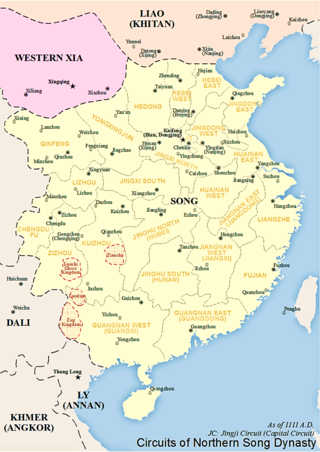
This is a timeline of the Song dynasty (960–1279). The Song dynasty was founded by Zhao Kuangyin, posthumously known as Emperor Taizu of Song, who ended the period of division known as the Five Dynasties and Ten Kingdoms period. The Song dynasty is commonly separated into two historical periods, the Northern Song (960–1127) and the Southern Song (1127–1279), divided by the loss of the north to the Jurchen Jin dynasty (1115–1234). In 1279, the Mongol Yuan dynasty conquered the Song.

This is a timeline of the Five Dynasties and Ten Kingdoms (907–979), which followed the collapse of the Tang dynasty in 907 AD. The Five Dynasties refer to the succession of dynasties which ruled northern China following the Tang collapse while the Ten Kingdoms, with the exception of Northern Han, ruled in southern China. This era of division ended in 979 AD with the rise of the Song dynasty under Emperor Taizu of Song, although the Song would never reconquer the northern territory lost to the Khitans, collectively known as the Sixteen Prefectures.

The military history of the Song dynasty encompasses military activity of the Han Chinese state of Song from 960 AD with the overthrow of Later Zhou until 1279 AD when China was conquered by the Mongol-led Yuan dynasty.


